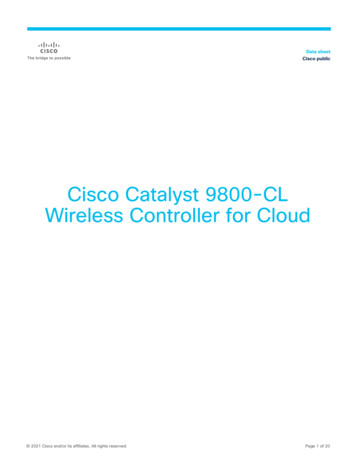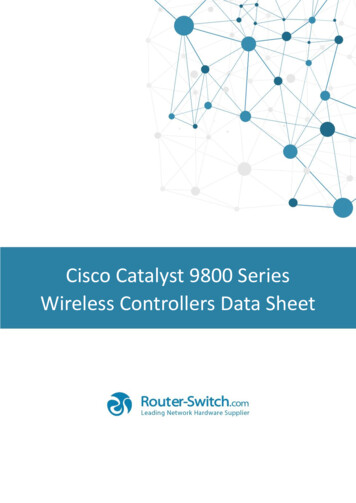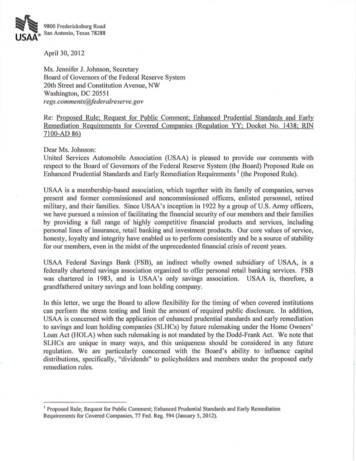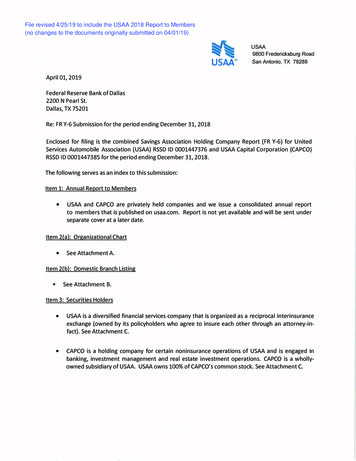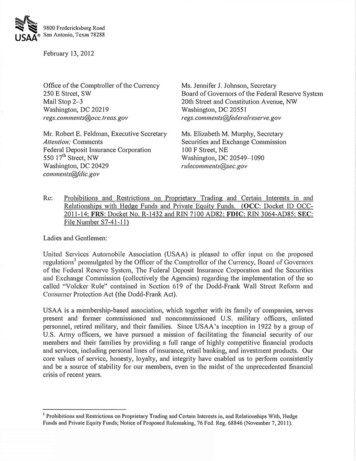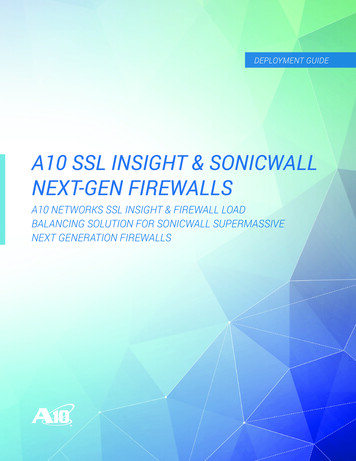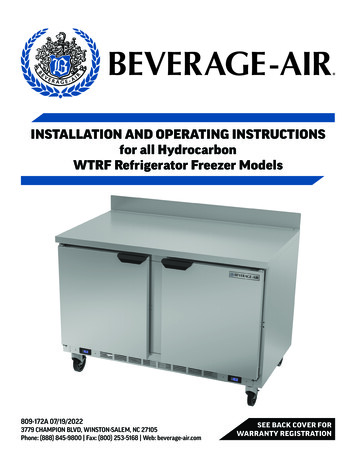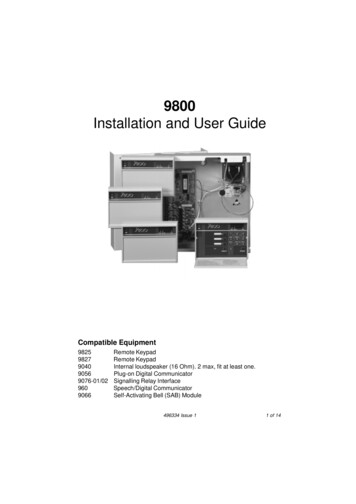
Transcription
9800Installation and User GuideCompatible Equipment98259827904090569076-01/029609066Remote KeypadRemote KeypadInternal loudspeaker (16 Ohm). 2 max, fit at least one.Plug-on Digital CommunicatorSignalling Relay InterfaceSpeech/Digital CommunicatorSelf-Activating Bell (SAB) Module496334 Issue 11 of 14
9800IntroductionThe 9800 Alarm Control Panel comprises a control unit in a shielded case,and up to four separate keypads.The control unit provides: Connections for up to eight Closed Circuit zones. Connections for four outputs (external sounder, strobe, and two fullyprogrammable outputs). Connections for up to four 9825 Keypads. Pins for fitting a plug-on communication device. Any device thatcomplies with the Scantronic plug-on footprint can be fitted. Internal sounder loudspeaker output with electronically generatedChime, Alarm and Fire tones.The programming interface is arranged as a set of two-digit numberedcommands.The system can provide for up to 4 separate users. User facilities include: Three different security levels (full set and two part sets) which can beprogrammed by the installer. User programmable Duress code. Keyswitch setting/unsetting.Technical SpecificationsGeneralOperating temperatureHumidityDimensionsWeightStandby Battery -10 C to 40 C. Up to 80% non-condensing. h x w x d 300 x 300 x 75 mm. 4.85 Kg (excl battery). 12 Volt, 6.0Ah rechargeable lead-acid, GelType battery.Power SupplyThe total current available from the control unit is as follows:System output current 800mA (Ambient Temp. 20 C).Control unit pcb 60mA quiescent. 500mA active (when driving standardexternal bell).Each 9825 Remote Keypad 20mA quiescent. 60mA active.2 of 14496334 Issue 1
98009825 Keypad AddressingStandard 9066 SAB ModulePlug-on 9056 Communicator 40mA. 40mA.Keypad WiringRecommended maximum distances for the remote keypads from the controlunit, using standard alarm cable is 100 metres for the star configuration.OutputsOP1, OP2, Bell, Strobe 500mA. Transistorised outputs capable ofdriving a relay.9825 Keypad AddressingBefore connecting the keypad(s) to the system, the engineer must set theaddress of each keypad. Each keypad in a system must have a differentaddress number to ensure that the control unit can correctly identify them.To set the address:1. Ensure the system is powered down.2. Open the keypad and identify the four position DIP switch on the keypadpcb, see Figure 1 below. Note that each switch is numbered 1 to 4. Thenumbers correspond to the keypad address.Figure 1. Keypad Address Switch3.Select one switch and move it to the ON position (up). Make sure all theother switches are OFF (down). The keypad now has the address givenby the switch that is ON.Adjusting Keypad Sounder VolumeYou can alter the volume of the keypad sounder by adjusting the potentiometer located next to the sounder. See Figure 1. When first installing thekeypad set the potentiometer midway using a small screwdriver.496334 Issue 13 of 14
9800WiringFigure 2 shows the main connector on the control unit PCB. Subsequentsections describe how to wire keypads and closed circuit zones.Figure 2. Main Connector4 of 14496334 Issue 1
9800Wiring KeypadsWiring KeypadsAll keypads must be connected to Keypad terminals on the control unit PCBor "daisy chained" to other keypads. Figure 3 shows the connections for eachkeypad using the 9285 as an example:Figure 3. Wiring the 9285 KeypadNote: The output for the lock release interface must be a transistorised type. Arecommended type is RS Components 349-254. A SEPARATE 12 Volt DCsupply is required. Contact rating is 10 A.Caution: Do not connect other devices (for example SAB, speakers and so on) in thesame cable as the remote keypad wiring.496334 Issue 15 of 14
Wiring Keyswitches9800Wiring KeyswitchesConnect a keyswitch to the I/P and 0V terminals of the nearest keypad (seeFigure 4). Make sure you use a two position, unbiased keyswitch.Figure 4. KeyswitchCommunicationsThe control unit can be fitted with communicators that conform to the standard Scantronic plug-on communicator footprint (for example, the 9056 and9058 Plug-on Digital Communicators, a 960 Speech/Digital Communicator,or a Plug-on Red Care Transmitter). For communicators that do not conformthe 9076-01 and 9076-02 can be used as interfaces to the system.6 of 14496334 Issue 1
9800ProgrammingInitial Power UpWhen all wiring is complete, power up the system for the first time as follows:1. Ensure that the keypad(s) and detectors are securely fitted and theirtamper switches closed.2. Connect the battery and then close the case.3. Switch on the mains power. Ignore any tones from the internal andkeypad sounders.4. Go to a keypad and key in 1234.5. Key in 0 followed by 7890 (the default Engineer’s code).The keypad gives an intermittent tone.6. Open the end station lid. (If the lid is already open, close and open thetamper switch.)The displays shows “E” (engineer).You are now in programming mode.Programming CommandsWhen delivered from the factory the control unit already has default programsettings. To change the default programming you must be in programmingmode. Then:1. Key in the appropriate command number.The display shows the current value of the command.2.Key in digits to select the value you require.The display shows a code giving the new value.3. Press Clear to store the new value of the command.If at any time you change your mind, repeat step 1 to 3. The table on thefollowing pages shows the commands and their options. ( A y next to acommand value shows that it is the factory default.)The factory default access codes are:Engineer Code7890Access Code User 11234Access Code 2 to 4AAAA (inactive)Access Code 3BBBB (inactive)Access Code 4CCCC (inactive)Duress CodeOMIT, OMIT, OMIT, OMIT (inactive)Note: The factory default Access Codes 02 to 04 and the Duress Code must bechanged by USER 1 to a four digit number to activate them.496334 Issue 17 of 14
Engineer Program Commands9800Engineer Program CommandsTo change:Zone nNotesDefaultn zone number 01 to 08x Zone type, one of:0 nu (not used)y1 PA (panic alarm)2 Fr (fire zone)3 Al (normal alarm)4 24 (24 hour zone)5 FE (final exit)6 ER (entry route)y Zone attributes, any of:7 ch (chime)8 St (soak test)9 2A (double knock)B b (armed in part set B)C c (armed in part set C)OMIT OA (omit allow)Example: Zone 3 is a Normal Alarm, active in Part Set B and C, that is Omit Allowed. Type in: 03 Zone Number3 Normal AlarmB Active in Part Set BC Active in Part Set COMIT Omit AllowCLEAR to store the value of the command.Output 111 x yx Output Type, one of:0 Bell follow1 Exit/entry follow2 Set latch type 1Y3 Set latch type 24 Shock sensor reset5 Walk test6 Entry system7 24 hour alarmy Output state, one of:8 positive appliedY9 positive removedOutput 212 x y(as for command 11)49Engineer Code20 nnnn Engineer code7890Bell Output Type21 0SAB, negative applied in alarmY1SCB, negative removed in alarmLoudspeaker Chime22 1Chime through loudspeaker & kypdsY0Chime through keypads onlyRedCare reset †23 0DisabledY1Enabled8 of 14Key-in:0n x y496334 Issue 1
9800To change:Duress modeInternal SounderSounder Delay on EntryPA ResponseNight Line Fault ResponseDay Line Fault ResponseSystem ResetPA ResetFirst circuit lockoutEntry AbortDay tamper comms †and Engineer on SiteKeypad InputExit ModeAuto Re-ArmBell DelayEngineer Program CommandsKey-in:24 0125 0126 0130 0131 0132 0133 0134 0135 0136 0137 0138 01239 01240 0123441 01234567NotesDefaultAudibleSilentYFollows external bellYContinuousNormalDelay alwaysYAudibleYSilentFull alarmNo alarmYAudibleYSilentUser resetYEngineer resetUser resetYEngineer resetLock outYRe-armDisabledYEnabled (90 seconds abort time)Disable (local audibles only)YEnabled, communicator channel 5Exit terminateYKeyswitchLocksetTimed or terminate setYFinal door setLock setNeverOnceYTwiceThree timesAlwaysNo delayY1.5 minutes3 minutes5 minutes10 minutes15 minutes20 minutesInfinite delay496334 Issue 19 of 14
Engineer Program Commands9800To change:Bell DurationKey-in:NotesDefault42 11.5 minutes23 minutes35 minutes410 minutes515 minutes620 minutesY7nilEntry Time43 110 SecondsY220 seconds330 seconds445 seconds560 seconds6120 secondsExit Time44 0Continuous (exit terminate only)110 SecondsY220 seconds330 seconds445 seconds560 seconds6120 secondsCSID Code50 n.n Seed code for remote resetAvailable from Jan 1993 on all models.Area B final exit response60 0Final exitY1Normal alarmArea B Entry route61 0Entry routeY1Start entry timerArea B Exit mode62 0As full set1Quick set (10s)Y2Instant set3Deferred setArea B Alarm response63 0Keypad sounders only1Internal and keypad soundersY2All sounders, no comms3Full alarm (comms and sounders)Area C final exit70see 60Area C Entry route71see 61Area C Exit mode72see 62Area C Alarm response73see 63Event log90 1View earlier events3View later eventsTest External Bells91 Bell output operatesClear Bell test endsTest Strobe92 Strobe output operatesClear Strobe test endsTest Internal sounder93 Internal sounder operatesClear Internal sounder test ends10 of 14496334 Issue 1
9800Leaving Programming ModeTo change:Test keypad sounderTest output 1Test output 2Walk TestLoad defaultsLeave programmingKey-in:Notes94 Keypad sounder operatesClear Keypad sounder test ends95 Programmable output 1 operatesClear Output 1 test ends96 Programmable output 2 operatesClear Output 2 test ends97 Zone LED and sounder operate whencircuit openClear End walk test98 Load defaults99DefaultLeaving Programming ModeWhen all programming has been completed:1. Key-in ‘99’ at the keypad.The display clears and the Day LED is ON.The system is now in user mode.Note: If there is a fault on the system , for example an open tamper circuit, thedisplay shows this and will not return to Day mode. Press Y (Clear) and rectifythe faults.Engineer ResetTo perform an Engineer Reset:1. Check that the display is showing the alarm condition. (Note: if thedisplay shows “rr”, Press Clear twice.)2. Key in 0 followed by the Engineer’s code (default 7890), followed by 99.The display goes blank and the Day LED glows.Re-Entering Programming Mode“Initial Power Up” describes how to enter programming mode for the first timein a new installation. If you wish to enter programming mode at any othertime:1. Make sure the system is unset.2. Press 0, then key in the Engineer’s code (default 7890).The keypad gives an intermittent tone.3.Open the end station lid.The display shows “E” (for ‘engineer’) and the intermittent tone stops.You are now in programming mode.496334 Issue 111 of 14
Refreshing the NVM9800Refreshing the NVMIf the user and/or engineer codes are lost, or you want to revert to the factorydefault programming, then:1. First remove mains power before opening the case and then disconnecting the battery.2. Identify and remove the NVM chip (IC4) on the main pcb (see Figure 1).3. Reconnect the battery, then re-apply mains power.4. Refit the NVM chip (note the locator marker position, see Figure 1).The end station loads the factory default access codes (User 1: 1234,engineer: 7890).5.Carry on to re-program the system.TestingYou may test parts of the system by entering commands at the keypad. Tocarry out a test make sure the system is in programming mode and then keyin one of the following commands. Press Clear to end each test:91To test the external sounder/bell.92To test strobe output.93To test the internal sounder output.94To test the keypad sounder.95To test programmable output No. 1.96To test programmable output No. 2.97To carry out a system walk test. This allows the engineer to test allalarm devices. When a circuit is opened, the internal sounder(s) willemit a tone and the appropriate circuit LED lights.Reading the LogThe control unit keeps a 60 event log of recent events. Each event is represented by a two digit code, shown on the next page. To review the event log,make sure the system is in programming mode, then:1. Key in 90.The display shows the most recent event in the log, for example "c7".For a list of the log codes see the next page.2.3.Key in 1 to show earlier events or 3 to see more recent events.Press Clear to leave the log.12 of 14496334 Issue 1
9800Event Log DisplaysThe table below shows all the messages that can appear in the event log.The left hand column shows the codes that appear on a keypad display.Event Log DisplaysKeypadAAAbAcAEAPbFc1 to c8cccFE1 to E8EAEFLbLfLto1 to o8PFr1 to r4rPrrrtS1 to S8Srt1 to t8tru1 to u9MeaningArm area A (full set)Arm area B (part set)Arm area C (part set)Installer accessAuxiliary power failureBattery faultZone violationCommunication successfulCommunications failureEntry via zone circuitEntry alarmExit faultLow batteryTelephone line failureEnd station lid tamperZone omittedMains power failureRemote keypad back tamperRemote keypad missingInstaller reset requiredRemote keypad excess key presses tamperZone soak TestSystem reset (total power failure)Zone tamper violationTamper return faultAccess user (u5 Duress, u9 keyswitch)496334 Issue 113 of 14
9800User CommandsSet/Unset SystemUser code APart SetUser code B or COmit zone (1-8)User code A, B or C OMIT Zone numberOmit 24 hour zoneUser code OMIT Zone numberReinstate omitted24 hour zoneUser code OMIT CLEARChange User codeUser code 4 old code new code CLEARRead LogUser code 5 1 to see earlier events or3 to see later events CLEAR CLEARChime On/OffUser code 7 CLEARBell TestUser code 8 CLEAR to end testWalk TestUser code 9 CLEAR to end testNote: Duress code default is OMIT OMIT OMIT OMIT and is inactive until changed.14 of 14496334 Issue 1
address of each keypad. Each keypad in a system must have a different address number to ensure that the control unit can correctly identify them. To set the address: 1. Ensure the system is powered down. 2. Open the keypad and identify the four position DIP switch on the keypad pcb, see Figure 1 below. Note that each switch is numbered 1 to 4. The
